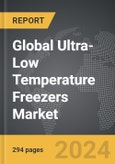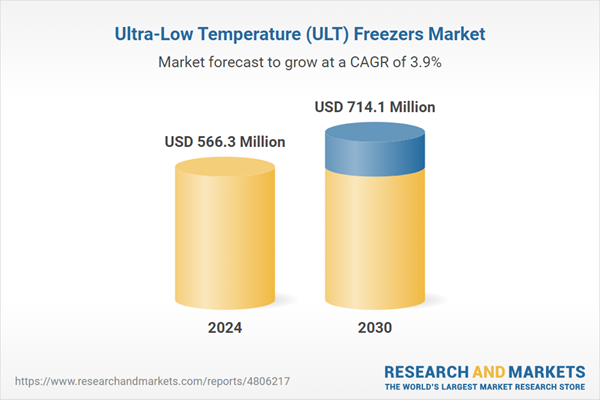The global market for Ultra-Low Temperature (ULT) Freezers was valued at US$566.3 Million in 2024 and is projected to reach US$714.1 Million by 2030, growing at a CAGR of 3.9% from 2024 to 2030. This comprehensive report provides an in-depth analysis of market trends, drivers, and forecasts, helping you make informed business decisions. The report includes the most recent global tariff developments and how they impact the Ultra-Low Temperature (ULT) Freezers market.
The growth in the ULT freezers market is driven by several factors. The increasing demand for biobanking and the storage of biological samples and pharmaceuticals is a major driver, fueled by advancements in medical research and the ongoing need for vaccine storage. Technological innovations that improve energy efficiency and reliability are encouraging wider adoption of ULT freezers. Additionally, the expansion of the pharmaceutical and biotechnology industries, particularly in emerging markets, is boosting demand. The rising focus on sustainability and the development of eco-friendly models are further propelling market growth, addressing both environmental concerns and operational efficiencies.
Segments: Type (Upright, Chest, Other Types).
Geographic Regions/Countries: World; United States; Canada; Japan; China; Europe (France; Germany; Italy; United Kingdom; Spain; Russia; and Rest of Europe); Asia-Pacific (Australia; India; South Korea; and Rest of Asia-Pacific); Latin America (Argentina; Brazil; Mexico; and Rest of Latin America); Middle East (Iran; Israel; Saudi Arabia; United Arab Emirates; and Rest of Middle East); and Africa.
The analysts continuously track trade developments worldwide, drawing insights from leading global economists and over 200 industry and policy institutions, including think tanks, trade organizations, and national economic advisory bodies. This intelligence is integrated into forecasting models to provide timely, data-driven analysis of emerging risks and opportunities.
Global Ultra-Low Temperature (ULT) Freezers Market - Key Trends & Drivers Summarized
How Are ULT Freezers Critical in Preserving Biological Samples?
Ultra-Low Temperature (ULT) freezers are essential for the long-term storage of biological samples, pharmaceuticals, and other sensitive materials that require extremely low temperatures. These freezers typically operate at temperatures between -80°C and -86°C, ensuring the integrity and viability of samples over extended periods. ULT freezers are widely used in research laboratories, biobanks, hospitals, and pharmaceutical companies to store vaccines, DNA/RNA samples, enzymes, and other critical biological materials. The demand for ULT freezers has surged, especially with the increased focus on biobanking and the storage of COVID-19 vaccines, underscoring their importance in the medical and scientific communities.What Technological Advancements Are Enhancing ULT Freezer Performance?
Technological advancements have significantly enhanced the performance and reliability of ULT freezers. Innovations in compressor technology, insulation materials, and temperature control systems have improved energy efficiency and reduced operational costs. Modern ULT freezers are equipped with advanced monitoring and alarm systems to ensure continuous operation and sample safety. Digital interfaces and connectivity features allow for remote monitoring and data logging, providing users with real-time information and greater control over their storage conditions. These advancements are critical in ensuring the consistency and reliability of ULT freezers, making them indispensable in settings where sample integrity is paramount.What Are the Challenges and Opportunities in the ULT Freezers Market?
Despite their critical role, ULT freezers face challenges such as high energy consumption and the need for regular maintenance to ensure optimal performance. The initial investment costs can be substantial, particularly for advanced models with sophisticated features. However, these challenges also present opportunities for innovation. The development of more energy-efficient models and the use of environmentally friendly refrigerants are gaining traction. Additionally, the growing emphasis on biobanking, personalized medicine, and the need for large-scale vaccine storage are expanding the market for ULT freezers. Manufacturers are focusing on enhancing sustainability and reliability to meet the evolving needs of the market.The growth in the ULT freezers market is driven by several factors. The increasing demand for biobanking and the storage of biological samples and pharmaceuticals is a major driver, fueled by advancements in medical research and the ongoing need for vaccine storage. Technological innovations that improve energy efficiency and reliability are encouraging wider adoption of ULT freezers. Additionally, the expansion of the pharmaceutical and biotechnology industries, particularly in emerging markets, is boosting demand. The rising focus on sustainability and the development of eco-friendly models are further propelling market growth, addressing both environmental concerns and operational efficiencies.
Report Scope
The report analyzes the Ultra-Low Temperature (ULT) Freezers market, presented in terms of units. The analysis covers the key segments and geographic regions outlined below.Segments: Type (Upright, Chest, Other Types).
Geographic Regions/Countries: World; United States; Canada; Japan; China; Europe (France; Germany; Italy; United Kingdom; Spain; Russia; and Rest of Europe); Asia-Pacific (Australia; India; South Korea; and Rest of Asia-Pacific); Latin America (Argentina; Brazil; Mexico; and Rest of Latin America); Middle East (Iran; Israel; Saudi Arabia; United Arab Emirates; and Rest of Middle East); and Africa.
Key Insights:
- Market Growth: Understand the significant growth trajectory of the Upright segment, which is expected to reach US$629.7 Million by 2030 with a CAGR of a 4.0%. The Chest segment is also set to grow at 4.3% CAGR over the analysis period.
- Regional Analysis: Gain insights into the U.S. market, valued at $151.6 Million in 2024, and China, forecasted to grow at an impressive 6.1% CAGR to reach $145.2 Million by 2030. Discover growth trends in other key regions, including Japan, Canada, Germany, and the Asia-Pacific.
Why You Should Buy This Report:
- Detailed Market Analysis: Access a thorough analysis of the Global Ultra-Low Temperature (ULT) Freezers Market, covering all major geographic regions and market segments.
- Competitive Insights: Get an overview of the competitive landscape, including the market presence of major players across different geographies.
- Future Trends and Drivers: Understand the key trends and drivers shaping the future of the Global Ultra-Low Temperature (ULT) Freezers Market.
- Actionable Insights: Benefit from actionable insights that can help you identify new revenue opportunities and make strategic business decisions.
Key Questions Answered:
- How is the Global Ultra-Low Temperature (ULT) Freezers Market expected to evolve by 2030?
- What are the main drivers and restraints affecting the market?
- Which market segments will grow the most over the forecast period?
- How will market shares for different regions and segments change by 2030?
- Who are the leading players in the market, and what are their prospects?
Report Features:
- Comprehensive Market Data: Independent analysis of annual sales and market forecasts in US$ Million from 2024 to 2030.
- In-Depth Regional Analysis: Detailed insights into key markets, including the U.S., China, Japan, Canada, Europe, Asia-Pacific, Latin America, Middle East, and Africa.
- Company Profiles: Coverage of players such as Azbil Telstar SL, Eppendorf AG, Eppendorf North America, Glen Dimplex Group, Global Cooling Inc. - Stirling Ultracold and more.
- Complimentary Updates: Receive free report updates for one year to keep you informed of the latest market developments.
Some of the 41 companies featured in this Ultra-Low Temperature (ULT) Freezers market report include:
- Azbil Telstar SL
- Eppendorf AG
- Eppendorf North America
- Glen Dimplex Group
- Global Cooling Inc. - Stirling Ultracold
- Haier Biomedical
- Macro Scientific Works Pvt. Ltd.
Tariff Impact Analysis: Key Insights for 2025
Global tariff negotiations across 180+ countries are reshaping supply chains, costs, and competitiveness. This report reflects the latest developments as of April 2025 and incorporates forward-looking insights into the market outlook.The analysts continuously track trade developments worldwide, drawing insights from leading global economists and over 200 industry and policy institutions, including think tanks, trade organizations, and national economic advisory bodies. This intelligence is integrated into forecasting models to provide timely, data-driven analysis of emerging risks and opportunities.
What’s Included in This Edition:
- Tariff-adjusted market forecasts by region and segment
- Analysis of cost and supply chain implications by sourcing and trade exposure
- Strategic insights into geographic shifts
Buyers receive a free July 2025 update with:
- Finalized tariff impacts and new trade agreement effects
- Updated projections reflecting global sourcing and cost shifts
- Expanded country-specific coverage across the industry
Table of Contents
I. METHODOLOGYII. EXECUTIVE SUMMARY2. FOCUS ON SELECT PLAYERSIII. MARKET ANALYSISIV. COMPETITION
1. MARKET OVERVIEW
3. MARKET TRENDS & DRIVERS
4. GLOBAL MARKET PERSPECTIVE
UNITED STATES
CANADA
JAPAN
CHINA
EUROPE
FRANCE
GERMANY
ITALY
UNITED KINGDOM
SPAIN
RUSSIA
REST OF EUROPE
ASIA-PACIFIC
AUSTRALIA
INDIA
SOUTH KOREA
REST OF ASIA-PACIFIC
LATIN AMERICA
ARGENTINA
BRAZIL
MEXICO
REST OF LATIN AMERICA
MIDDLE EAST
IRAN
ISRAEL
SAUDI ARABIA
UNITED ARAB EMIRATES
REST OF MIDDLE EAST
AFRICA
Companies Mentioned (Partial List)
A selection of companies mentioned in this report includes, but is not limited to:
- Azbil Telstar SL
- Eppendorf AG
- Eppendorf North America
- Glen Dimplex Group
- Global Cooling Inc. - Stirling Ultracold
- Haier Biomedical
- Macro Scientific Works Pvt. Ltd.
Table Information
| Report Attribute | Details |
|---|---|
| No. of Pages | 294 |
| Published | April 2025 |
| Forecast Period | 2024 - 2030 |
| Estimated Market Value ( USD | $ 566.3 Million |
| Forecasted Market Value ( USD | $ 714.1 Million |
| Compound Annual Growth Rate | 3.9% |
| Regions Covered | Global |









